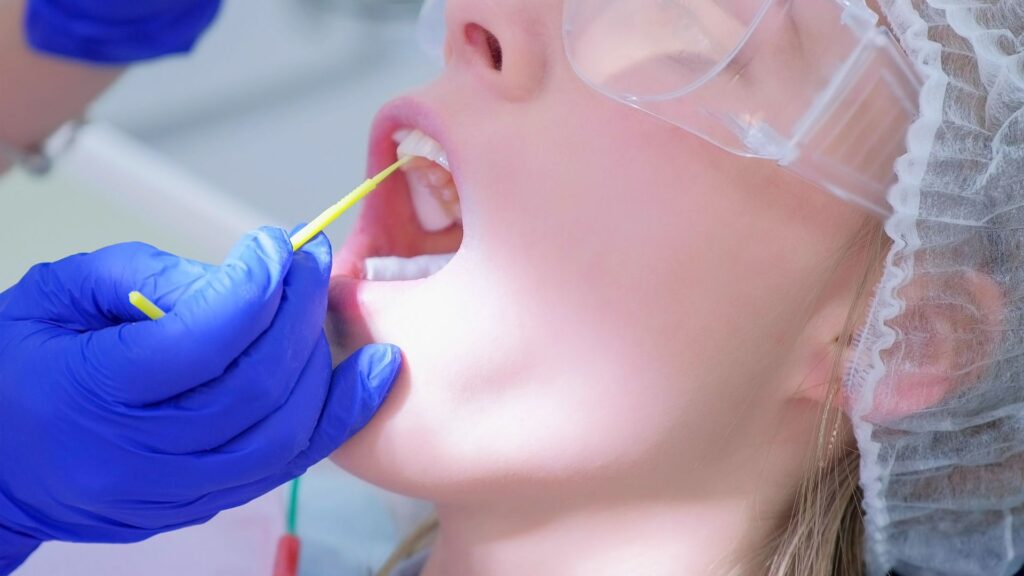Fluoride has played a key role in modern dentistry for decades. Whether it’s added to toothpaste or applied by a dentist, fluoride helps protect your teeth from cavities and strengthens the enamel. But how effective is fluoride treatment? Is it safe for everyone? And is it worth getting done at the clinic if you’re already using fluoride toothpaste?
This blog will explain the science, benefits, and facts about fluoride treatment so you can make an informed choice about your oral health.
What Is Fluoride Treatment?
Fluoride treatment is a preventive dental procedure in which a dental professional applies concentrated fluoride directly to the teeth. Unlike fluoride found in toothpaste or drinking water, this treatment contains a higher amount of fluoride for stronger protection.
It’s available in different forms—varnish, gel, foam, or rinse—and is usually done during a regular dental check-up. The goal is to strengthen tooth enamel and make it more resistant to acid attacks caused by bacteria and food.
How Fluoride Works to Protect Teeth
Understanding why fluoride matters helps to know how cavities form. Every time you eat, bacteria in your mouth break down sugars and release acid. This acid slowly wears away your enamel—a process called demineralization.
Fluoride helps reverse this damage through a process known as remineralization. It encourages the growth of new enamel crystals, which are stronger and more resistant to decay
Topical fluoride, when professionally applied, can reduce cavities by up to 40% in children and up to 35% in adults. – Journal of Dental Research, 2022
It also helps stop early-stage tooth decay from turning into a cavity that requires drilling or filling.
Benefits of Professional Fluoride Treatment
While brushing twice a day with fluoride toothpaste is essential, professional fluoride treatment adds an extra layer of defense—especially if you are at higher risk for cavities. It is often recommended for:
- Children with developing teeth
- Adults with gum recession or dry mouth
- Patients undergoing orthodontic treatment
- People with a high-sugar diet or poor oral hygiene
Fluoride treatment can reduce tooth sensitivity, strengthen weak spots on teeth, and slow down or even reverse early signs of decay.
According to the Indian Dental Association (IDA), fluoride treatment is one of the safest and most effective preventive measures against dental decay when used appropriately.
Who Should Consider Getting It?
While fluoride is beneficial for almost everyone, certain groups benefit more:
- Children and teenagers with newly erupting permanent teeth need additional fluoride to ensure strong enamel.
- Adults who frequently get cavities or have exposed roots due to receding gums.
- People with dry mouth are caused by medication or medical conditions, where less saliva increases the risk of decay.
- Patients with braces or crowns may find it harder to clean all surfaces effectively.
If you’re unsure whether you need fluoride treatment, a dental check-up can help assess your cavity risk and oral health needs.
Safety, Side Effects, and Common Misunderstandings
There is a lot of misinformation about fluoride. One common concern is fluorosis, a condition that causes white spots on teeth. However, fluorosis only occurs with long-term overexposure to fluoride during childhood.
The amount of fluoride used is carefully measured in a clinical setting. When performed by a qualified dentist, the procedure is quick and completely safe
The World Health Organization (WHO) supports the use of fluoride in both community water and clinical dental settings as a key tool in public oral health.
There are no proven links between fluoride treatment and serious health risks like cancer. Mild side effects, such as slight nausea, may occur if fluoride is swallowed in excess, which is why supervision during treatment is essential, especially for children.
What Happens During a Fluoride Treatment?
Fluoride treatment at a dental clinic is painless and takes just a few minutes. Here’s what you can expect:
- The dentist dries your teeth.
- Fluoride in the form of varnish, gel, or foam is applied using a brush or tray.
- You are asked to avoid eating or drinking for 30 minutes to let the fluoride absorb.
It’s recommended every six months, though some high-risk patients may need it more frequently.
Fluoride treatments are beneficial for patients with recurring cavities, exposed root surfaces, or after orthodontic treatments.
Cost of Fluoride Treatment in India
Professional fluoride treatments are affordable, especially when compared to the cost of filling a cavity or root canal treatment later.
|
Type of Fluoride |
Form | Best For | Frequency |
Application Time |
| Varnish | Thick coating | Kids & sensitive teeth | 2–4 times/year | 1–4 mins |
| Gel | Tray-based | Teens/adults at risk | 1–2 times/year | ~4 mins |
| Foam | Tray-based | General prevention | 1–2 times/year | ~4 mins |
| Rinse | Mouthwash style | Home-use maintenance | Daily/Weekly | <1 min |
In India, fluoride treatment typically costs between ₹200 to ₹600 per session, depending on the dental clinic and location. Some clinics offer it as part of routine check-ups.
Frequently Asked Questions
Is fluoride treatment safe for children?
Yes, fluoride treatment is safe for children when applied by a dentist using the correct dosage. It helps protect developing teeth from decay and strengthens enamel during the early stages of growth.
How often should I get fluoride treatment?
Most people benefit from fluoride treatment every six months. However, those at higher risk for cavities may require more frequent treatments based on their dentist’s evaluation.
Does fluoride treatment cause fluorosis?
Fluorosis occurs from excessive fluoride intake over time, especially during childhood. Professionally applied fluoride treatments use controlled doses, making them safe and unlikely to cause fluorosis.
Can adults benefit from fluoride treatments?
Yes, adults with gum recession, frequent cavities, or dry mouth conditions can benefit significantly from fluoride treatment as it strengthens enamel and prevents decay.
Is fluoride treatment painful?
No, fluoride treatment is quick, painless, and non-invasive. The process involves applying a fluoride varnish, gel, or foam, which takes just a few minutes.
What’s the difference between fluoride in toothpaste and clinical treatment?
Toothpaste provides low-level daily fluoride, while professional treatments offer higher concentrations for deeper enamel protection. Clinical applications are more effective for preventing decay in high-risk individuals.
Conclusion
Fluoride treatment is a simple, cost-effective way to protect your teeth against decay and enamel erosion. Whether you’re a parent looking out for your child’s dental health or an adult dealing with recurring cavities, fluoride treatment can be a smart preventive step
At Family Dental Clinic, Mira Road, we offer professional fluoride treatments tailored to your oral health needs. We follow all safety protocols and use only approved fluoride materials. Book a consultation to learn whether fluoride treatment is proper for you.
Sources & References
- Indian Dental Association – https://www.ida.org.in
- World Health Organization Oral Health Facts – https://www.who.int
- Journal of Dental Research, 2022, DOI: 10.1177/00220345221127601
- Dental Council of India – https://www.dciindia.gov.in
- Advertising Standards Council of India – https://ascionline.in








